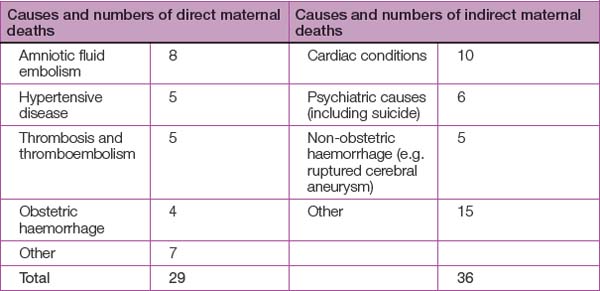Chapter 43 Maternal mortality
Maternal age is an important risk factor for both obstetric and perinatal outcomes. Adverse outcomes are more likely to occur in younger and older mothers. More Aboriginal or Torres Strait Islander mothers have their babies at a younger age compared with non-Indigenous mothers. One in five (19.5%) Aboriginal or Torres Strait Islander mothers is a teenager, compared with 3.5% of non-Indigenous mothers.
Background facts
In Australia, in the triennium 2003–05, there were 65 maternal deaths (29 direct and 36 indirect) and 34 incidental deaths (see Table 43.1). There were no deaths from termination of pregnancy procedures. Over the past five trienniums, the maternal mortality rates for Indigenous women were between two and five times the maternal mortality rates for non-Indigenous women.
Definitions
The World Health Organization definition of maternal mortality is the death of a woman while pregnant or within 42 days of the termination of pregnancy, irrespective of the duration and site of the pregnancy, from any cause related to or aggravated by pregnancy or its management, but not from accidental or incidental causes. It also includes deaths from assisted reproduction technologies where pregnancy has not occurred, but not from incidental causes. In most Australian states and territories, incidental deaths are included in the definition.
Classifications
Callister L.C. Global maternal mortality: contributing factors and strategies for change. MCN: American Journal of Maternal / Child Nursing. 2005;30:184-192.
Laws P., Sullivan E.A.. Australia’s mothers and babies 2007. Perinatal Statistics Series No. 23. Cat. No. PER 48, 2009. AIHW National Perinatal Statistics Unit, www.preru.unsw.edu.au/PRERUWeb.nsf/page/AIHW+National+Perinatal+Statistics+Unit Available at:
Lewis G., editor. The Confidential Enquiry into Maternal and Child Health (CEMACH). Saving mothers’ lives: reviewing maternal deaths to make motherhood safer 2003–05. The seventh report on confidential enquiries into maternal death in the United Kingdom. London: Royal Society of Medicine Press, 2008.
Stover J., Ross J.. How increased contraceptive use has reduced maternal mortality. Maternal Child Health Journal, 2009. www.springerlink.com/content/x182m5012uk6157m/ Available at:
Sullivan E.A., Hall B., King J.F.. Maternal deaths in Australia 2003–05. 2008. AIHW National Perinatal Statistics Unit, Maternal Deaths Series No. 3 Cat. No. PER 42. www.preru.unsw.edu.au/PRERUWeb.nsf/page/AIHW+National+Perinatal+Statistics+Unit Available at:
World Health Organization (WHO). Maternal deaths disproportionately high in developing countries. www.who.int/mediacentre/news/releases/2003/pr77/en/index.html, 2003. Available at:
World Health Organization (WHO). Maternal mortality in 2005. In estimates developed by WHO. UNFPA and the World Bank: UNICEF; 2007. Available at: www.who.int/mediacentre/news/releases/2003/pr77/en/index.htmlGeneva: WHO



